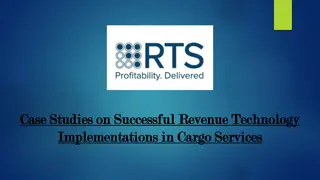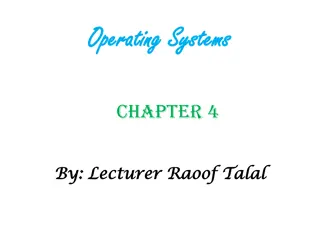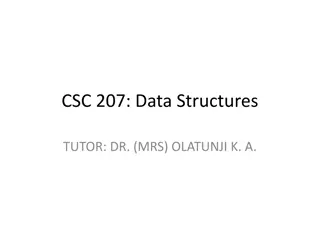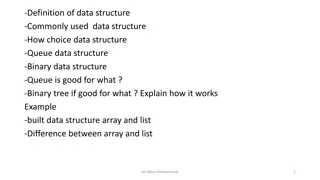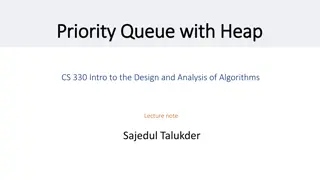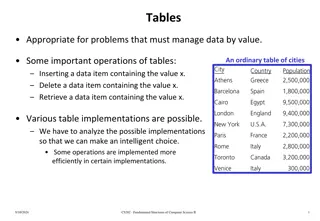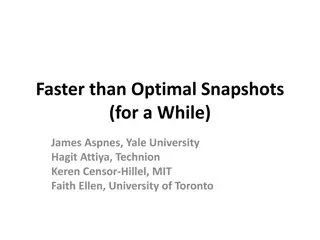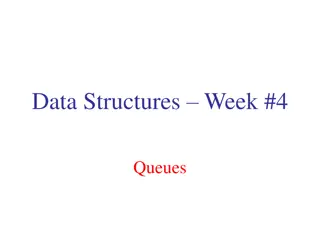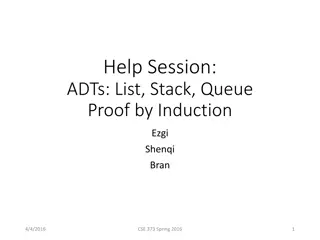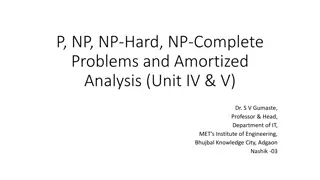Amortized Analysis in Data Structures: Insights and Implementations
Amortized analysis plays a crucial role in understanding the average running time per operation in worst-case scenarios for data structures. This content delves into implementing lists using circular arrays with resizing strategies, lazy deletions in singly linked lists, and explores the costs associated with different operations. It covers concepts such as doubling the size of arrays when full, handling insertions and deletions efficiently, and the implications of various operations on overall performance.
Download Presentation

Please find below an Image/Link to download the presentation.
The content on the website is provided AS IS for your information and personal use only. It may not be sold, licensed, or shared on other websites without obtaining consent from the author. Download presentation by click this link. If you encounter any issues during the download, it is possible that the publisher has removed the file from their server.
E N D
Presentation Transcript
Data Structures Lecture 2 Amortized Analysis Amortized analysis finds the average running time per operation over a worst-case sequence of operations. Haim Kaplan, Uri Zwick March 2018
Implementing lists using (circular) arrays with resizing n=M L array maxlen length aM 1 a0 a1 M M M What do we do when the array is full? Usually, we cannot extend the array. Allocate a larger array and copy. What should be the size of the new array?
Implementing lists using (circular) arrays with resizing n=M L array maxlen length aM 1 a0 a1 M M M If we start with an empty array and increase its length by 1, then the time to do n Insert-Last is about: Average/amortized time (charge) per operation = O(n)
Implementing lists using (circular) arrays with doubling When the array is full, double its size and copy. Suppose that final size is 2?< ? 2?+1 cost of copying cost of insertion The amortized cost of each operation is O(1)
Lazy deletions from singly linked lists A L a0 a1 an-1 Delete-Node(A) simply sets A.item to null Retrieve-Node(L,i) deletes empty nodes while scanning for the i-th item worst(Insert-After) = O(1) worst(Delete-Node) = O(1) worst(Retrieve-Node(i)) = unbounded
Lazy deletions from singly linked lists L a0 an-1 Insert-Node(L,i) is similar
Lazy deletions from singly linked lists L a0 an-1 What is the total cost of a sequence composed of ? Insert-After operations, ? Delete-Node operations, ? Retrieve-Node(?) operations on positions ?1,?2, ,??, in any order? ? ? Total cost = ? ? + (??+??+ 1) + ? = ? ? + (??+ 1) + 2? ?=1 ?=1 ? amort(Insert-After) = ?(1) amort(Retrieve(i)) = ?(? + 1) amort(Delete-Node) = ?(2) Number of deleted nodes encountered during Retrieve(??) ?? ? ?=1
Worst-case bounds Suppose that a data structure supports ? different types of operations ?1,?2, ,??. Let ?????(??) be the maximal time that a single operation of type ??may take. For an operation ??, let ?(??) be its type. For every sequence ??1,??2, ,???of operations: ? ???? ??1,??2, ,??? ?=1 ????? ? ??? Sometimes, this bound is very loose. ?????(Insert-Last) = ?(?) ?????(? Insert-Last) = ? ? ? ?2
Amortized bounds ????? ?1,????? ?2, ,????? ?? are amortized bounds on the cost of operations of types ?1,?2, ,??iff for every valid sequence ??1,??2, ,???: ? ???? ??1,??2, ,??? ?=1 ????? ? ??? Worst-case bounds are also amortized bounds. There can be many possible sets of amortized bounds. We prefer amortized bounds that give tighter bounds. Some operations subsidize other operations.
Why do we care about amortized bounds? Usually, we are more interested in the total cost of a sequence of operations, and not in the individual cost of each operation in the sequence. Amortized bounds allow us to derive good bounds on the total cost. There are cases in which it is important that each individual operation is fast. In such cases, amortized bounds are not sufficient.
Simple examples of amortized bounds Dynamic arrays: Insert-First/Insert-Last has ?(1) amortized cost, even though some operations require expensive resizing. Lazy deletions from singly linked lists: Delete-Node has ?(1) amortized cost (and worst-case cost). Retrieve(i) has ? ? + 1 amortized cost (but unbounded worst-case cost) Push/Pop on a stack: Suppose Push and Pop require only 1 time unit. ?????(Push) = 1 , ?????(Pop) = 1 ?????(Push) = 1 , ?????(Pop) = 1 ?????(Push) = 2 , ?????(Pop) = 0 assuming number of Pop s number of Push s
Methods for deriving amortized bounds We saw some examples of deriving amortized bounds using bare hands . It is not always as easy We can use some help! The accounting method The potential method
Coin operated computer A token/coin pays for a constant number of operations. Each operation may buy tokens and 1. Use them immediately 2. Leave tokens for subsequent operations 3. Use tokens left by previous operations Number of tokens bought is clearly an upper bound on the cost of operations performed.
The Accounting method Saving for a rainy day - Keep something, esp. money, for a time in the future when it might be needed Each normal insert operations buys three tokens. It uses one of them to insert the new item. It leaves the other two in the bank When the array is full, the bank contains enough tokens to pay for the copying! What about the cost of allocating the new array?
The Accounting method Theorem: If the array contains M/2+k items, where k 0, then the bank contains at least 2k tokens. Easy proof by induction Corollary: When the array is full, the bank contains enough tokens to pay for copying all the items into a new array Amortized cost of an operation number of tokens bought by the operation Note: Tokens are only used in the analysis! The data structure doesn t really manipulate them.
Implementing lists using arrays with doubling n L array maxlen length aM 1 a0 a1 M n M amort(Insert-Last) = 3 amort(Delete-Last) = 1 amort(Insert(i)) = n i+3 amort(Retrieve(i)) = 1
The Potential method Very similar to the accounting method. The difference: Instead of specifying in advance how many tokens each operation should buy, specify how many tokens should be in the bank in each state of the data structure Potential Balance of bank account ????? ?? = ???? ?? + after before ????? ? = max ?? ?????? ??
The Potential method Bank account initially empty 0 No overdraft!
The Potential method (recap) Define a potential function 0 This holds for any potential function 0 To get good amortized bounds, we need to choose cleverly
Potentials for expanding arrays When array is not full 2 1 When array is full 2 M M+1 At most 3 in both cases!
Potentials for expanding arrays 0 1 0 1 The amortized cost of Delete-Last is sometimes negative. When?
Not only doubling Trade-offs between time and space Suppose that instead of doubling, we multiply the size of the array by 1 + ?, where ? > 0. Amortized cost of Insert-Last is Exercise: Find an appropriate potential function. Python s implementation of lists essentially uses ? = 1/8.
Expanding and shrinking arrays What do we do when a very large array contains very few elements? When ? = ?, double the size When ? = ?/2, half the size ? Both worst-case and amortized costs are O(n)
Expanding and shrinking arrays What do we do when a very large array contains very few elements? When ? = ?, double the size When ? = ?/4, half the size ! Amortized cost now O(1) Which potential function should we use?
Expanding and shrinking arrays (Dynamic arrays) We always have ? 4 ? ?
De-Amortization In some cases, but not all, amortized bounds can be converted into worst-case bounds. For example, in dynamic arrays, instead of leaving two tokens for future operations, we can actually move two elements. Can we do something similar with lazy singly linked lists?
De-Amortized dynamic arrays L.small ?/2 L.medium ? L.large 2? L.medium is always up to date If L.medium is full then L.large is up to date If L.medium is full then L.small is up to date Updates may need to be performed on all three lists
De-Amortized dynamic arrays L.small ?/2 L.medium ? L.large 2? L.medium is always up to date. If L.medium contains then L.large contains the first 2? items. ? 2 + ? items, If L.medium contains then L.small contains the first ? items. ? 2 ? items, Insert/Delete-First/Last and Retrieve(i) take O(1) worst-case time, assuming the allocation of new arrays takes O(1) time. Exercise: Fill in the implementation details.
Amortized vs. Worst-case Amortization gives worst-case bounds for a whole sequence of operations. In many cases, this is what we really care about. In some cases, such as real-time applications, we need each individual operation to be fast In such cases, amortization is not good enough.



















